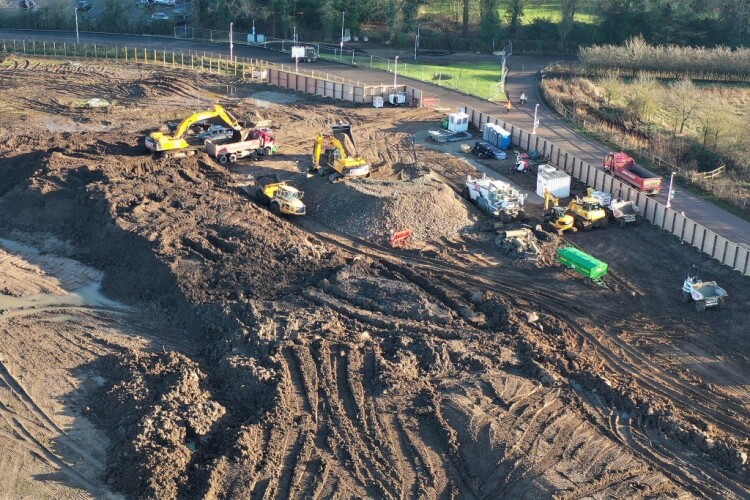Working for main contractor Curo Construction, O’Keefe’s enabling works package on Shinfield Studios includes cut-and-fill stabilisation and the construction of pile mats, roads, deep drainage and retaining walls.
Shinfield Studios is a new film and television studio currently in development. Phase 1, comprising four sound stages, workshops and offices, is already operational. Phase 2 is still under construction with completion scheduled for spring 2023. Phase 3 and 4 will follow, with completion in 2024.
Construction on the current phase began in the latter part of last year. This million-plus square-foot development comprises 18 soundstages, workshops, office space, a multi-storey car park and external works which requires large-scale cut-and-fill, ground stabilisation and drainage.
Poor ground conditions meant that a solution was needed to bring the site up to the required earthworks specification. During the tender design period in October 2021, O’Keefe proposed a cost-saving solution entailing soil stabilisation and the use of a proprietary Tubosider stormwater system as part of the site drainage element.
“Curo were interested in the stabilisation of the fill material as it offered a saving to muck away and import of aggregate,” said O’Keefe’s site manager, Damian Grant. Although this solution required the delivery of a lot of lime to site, the volume of material required and the number of vehicle movements involved was massively reduced and carbon emissions thereby minimised.
The cost and environmental impact of excavating the site and replacing poor soil with imported fill was prohibitive whereas using stabilisation to bring site-won material up to the standards of an engineering fill for reuse was better both economically and environmentally.
“The only other alternative was to reuse the site-won material without any treatment – but that would have failed because there was no way it could be installed to the earthworks specification,” Damian Grant added.
Although an economical solution, stabilisation was a huge undertaking, requiring the treatment of 170,000 m3 of soil over an area of 695,000 m2.

There was also a technical obstacle to overcome. “There was some testing carried out previously on the site-won material and it came back with a high sulphate content,” Mr Grant said. “Sulphates have a chemical reaction with lime which can make the ground heave and swell.”
O’Keefe visited the site and collected samples of the materials from the cut. The samples were then analysed in O’Keefe’s geotechnical laboratory and tested alongside trial mixes using lime and ground-granulated blast-furnace slag (GGBS) in varying proportions.
“GGBS is used to eliminate the risk of swell when lime is added to highly contained sulphate material,” said Mr Grant. “The samples with lime/GGBS were placed in a soaking tank for 28 days and monitored for swell.”
Samples were also sent to I2 Analytics, an independent laboratory in Watford to double-check organic and sulphate levels.
After testing, O’Keefe offered Curo a mix design to meet the earthworks specification using lime and GGBS. “Lime on its own was sufficient to meet the earthworks specification, but without the addition of GGBS there was no way of eliminating the sulphate issue and the risk of heave,” said Mr Grant.
Besides delivering a solution for the ground improvements, O’Keefe was also required to install 1,500 linear metres of site drainage and more than 600 metres of retaining walls across the site.
Galvanised steel Tubosider tanks and culverts were used to construct the site’s drainage and rainwater attenuation system. O’Keefe’s solution involved digging out to the bottom of the tank level and creating a 1:2 batter before installing Bentofix geosynthetic clay liners and a shingle base.
It was then a matter of laying the pipes, installing gaskets and clamps before back-filling with 20/40mm stone and compacting. The pipes vary in size from 900mm diameter to 2.2 metres. The holding tanks ranged in capacity from 1,187 m3 to 2280 m3.
O’Keefe, which was acquired by Byrne Group last year after falling into administration, also managed to achieve cost savings with the retaining wall design. These were originally designed as pre-cast units, reducing the amount of on-site work required for their construction. But pre-cast had a long lead-time and O’Keefe calculated that it was quicker and more cost-effective to build them in-situ. O’Keefe therefore employed consulting engineer Byrne Looby to design in-situ concrete retaining walls in varying heights from 1.2 to 4.5 metres and from 300mm to 45mm in width.
Got a story? Email news@theconstructionindex.co.uk




